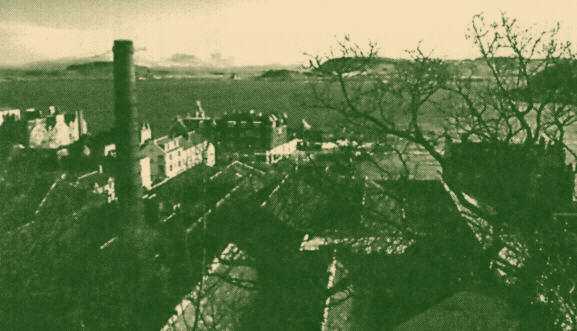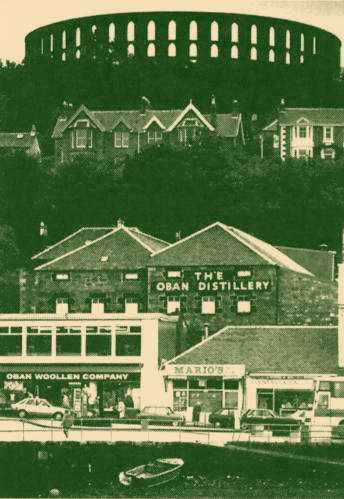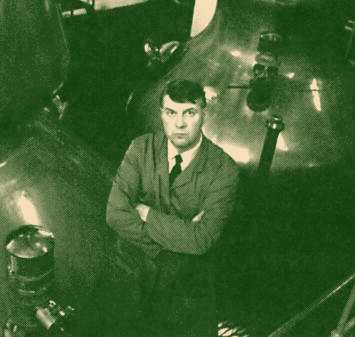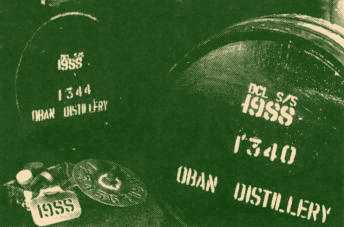

The first glimpse of Oban is spectacular, no matter how youapproach the town. From the North, the A85 descends through acleft in the ridge and, as it winds down the hill, the town withits bay spreads out below. The railway is no less dramatic, forit emerges from a cutting suddenly into the middle of the town,and the trains come to a halt a few paces from the shore. But thebest approach is from the sea, by way of Kerrera Sound or, fromthe North, by Dunollie Castle on the point. Then the town appearsas a semi-circle; an amphitheatre whose terraces are streets ofgrey Victorian villas backing onto a cliff surmounted,improbably, by what appears to be a minor Coliseum.
Although this is the principal entrepot of the West Highlands,it is important to grasp the scale of the town. From MacCaig'sFolly (the Coliseum affair) the cliff falls seventy feet or so,and to walk in a straight line from its foot to the shore willtake you all of three minutes. Between cliff and strand are a seawall, a road, some shops and a distillery.
The distillery is a range of fine, warehouse-like buildingssurmounted by an iron-banded chimney. The buildings are of greygranite like the villas, and they are subject to what seems alocal obsession with architectural form, for the surrounds ofwindows and doors all are painted, as if in emphasis of theirfunction. The chimney is red brick, painted red.
 It is a very urban distillery; economically,spiritually and geographically. If the bay were a lamp, its lightwould be the distillery and the island of Kerrera the focus ofits illumination. About two centuries ago, distillery and townwere founded by the Stevensons, a family of entrepreneurs ofstartling ambition and energy. The present distillery offices arehoused in their former residence. The distillery is one of thelargest employers in the town and the distilling staff are thearistocracy of local labour.
It is a very urban distillery; economically,spiritually and geographically. If the bay were a lamp, its lightwould be the distillery and the island of Kerrera the focus ofits illumination. About two centuries ago, distillery and townwere founded by the Stevensons, a family of entrepreneurs ofstartling ambition and energy. The present distillery offices arehoused in their former residence. The distillery is one of thelargest employers in the town and the distilling staff are thearistocracy of local labour.
The water for the whisky comes from a loch in the hills behindthe town. The name of the loch is easy to say but, in the truetradition of Gaelic orthography, almost impossible to spell. Themalt, which is lightly-peated, is not made locally, but isdelivered by truck from a central maltings. It is steeped in astainless steel mashtun and fermented in four wooden washbacks:vessels which, like the whisky casks themselves, are made by acooper and depend for their impermeability solely upon the fit ofstave against stave. The staves are twenty feet long.
The still house is tiny: a wash still and a spirit stillproceed at a leisurely pace in a finely-balanced distillation.Both are swan-necked and the spirit still has a lye pipe whichbends at a curious angle as it passes through the wall to theworm condenser - which is not a worm at all, but a series ofcopper pipes which run back and forth, the length of a stainlesssteel tank. They do not look like a worm, but they do the work ofone, and Ian Williams, the manager and distiller, explains thatthe bent pipe and the stretched worm are only two of theindividual features whose influences combine to produce ahighly-distinctive distillate.
 Not least among those influences is Ian himself. Atall, fair Aberdonian, he has worked in the whisky industry sinceshortly after leaving school and has been at Oban as managersince 1983. Two things are immediately evident: his totaldedication to his distillery and his confidence in his company.The latter is well-justified, for Ian has found ready support inthe upper echelons of the company for his determination thatevery idiosyncrasy of the distillery be preserved, despite thecontinuing cost of doing so.
Not least among those influences is Ian himself. Atall, fair Aberdonian, he has worked in the whisky industry sinceshortly after leaving school and has been at Oban as managersince 1983. Two things are immediately evident: his totaldedication to his distillery and his confidence in his company.The latter is well-justified, for Ian has found ready support inthe upper echelons of the company for his determination thatevery idiosyncrasy of the distillery be preserved, despite thecontinuing cost of doing so.
This is worth mentioning, for large distillery groups oftentake stick for actions which appear to reflect the short-termismtypical of so much of British industry. In fact, the whiskyindustry has always had long perspectives: they are intrinsic toa product which needs ten years between production and sale.Nonetheless, it is good to be able to report that Uniteddistillers, the proprietors of Oban distillery, appear to be wellaware that the individuality of the distillery is essential tothe character of the malt, and are prepared to sacrifice profitin the long-term interest of quality and identity.
It is a view which will support both tradition and innovation.When the mashhouse needed to be rebuilt, Ian asked that it bekept traditional: no automation, no computers, just the attentionof a conscientious mashman. This was duly done. On the otherhand, when he sought to respond to the growing demand fordistillery tours, he was able to convert the old filling storeinto a highly-successful visitors' centre. Its tableau ofcaveperson eating fish is a useful illustration of the advance intable manners since the upper mesolithic, but a bit over the topas an introduction to whisky. That apart, however, the wholething is well done and the punters love it.
 They love the whisky too, and with reason, for it isgood stuff. It is matured in refill casks for fourteen years andthe result is an excellent dram of considerable character. One'sonly grouse, from a Society point of view, is as regards thecasks. These are supplied by the parent company's cooperages.They are well-chosen to ensure a consistent maturation of highquality - but of course their very consistency leaves littlescope for the kind of variation which we in the Society arenormally able to exploit. Ian Williams is in no doubt: this isthe best sort of cask for the maturation of his spirit. It wouldbe churlish to disagree with such conviction.
They love the whisky too, and with reason, for it isgood stuff. It is matured in refill casks for fourteen years andthe result is an excellent dram of considerable character. One'sonly grouse, from a Society point of view, is as regards thecasks. These are supplied by the parent company's cooperages.They are well-chosen to ensure a consistent maturation of highquality - but of course their very consistency leaves littlescope for the kind of variation which we in the Society arenormally able to exploit. Ian Williams is in no doubt: this isthe best sort of cask for the maturation of his spirit. It wouldbe churlish to disagree with such conviction.
Ian's assurance on matters to do with his distillery isbalanced by a becoming modesty in most other things. It is acharacteristic which has universal appeal and no doubt is afactor in the demand abroad for his services as one of UD's brandambassadors. A Scottish distillery manager is the genuine articleand is regarded as an exotic in places like Japan and America,hence the proliferation of requests for Ian's presence. It is notuncommon for such celebrity to go to the head and it is pleasingto be able to report that Ian Williams seems to be largelyimmune. He rations his overseas visits quite severely, arguingthat his value and his authenticity lie in his being the managerof Oban distillery, and that he can't claim to be that if he isall the time traipsing off to foreign lands.
Phillip Hills
If you have comments about thissite, please contact the